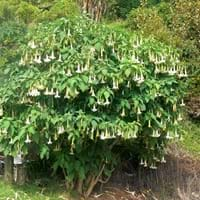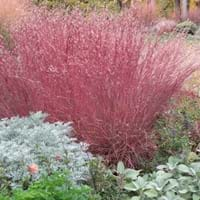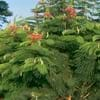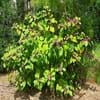Life Span
Perennial
Annual
Origin
Hybrid origin
North America, United States, Northeastern United States, Mid-Atlantic United States, Southeastern United States, North-Central United States, Central United States, South-Central United States, Southwestern United States, Mexico
Types
Not Available
Greener Pastures
Habitat
Tropical regions
Grassland
USDA Hardiness Zone
8-14
4-9
AHS Heat Zone
12-7
10 - 3
Sunset Zone
H1, H2, 12, 13, 16, 17, 18, 19, 20, 21, 22, 23, 24
1a, 1b, 2a, 2b, 3a, 3b, 4, 5, 6, 7, 8, 9, 10, 11, 12, 13, 14, 15, 16, 17, 18, 19, 20, 21, 22, 23, 24
Habit
Upright/Erect
Clump-Forming
Flower Color
White, Pink
Purple
Flower Color Modifier
Bicolor
Bicolor
Fruit Color
Light Yellow
Not Available
Leaf Color in Spring
Green
Light Green
Leaf Color in Summer
Green
Light Green
Leaf Color in Fall
Green
Red, Purple
Leaf Color in Winter
Green
Tan
Leaf Shape
Trumpet
Grass like
Plant Season
Spring, Summer, Fall, Winter
Summer, Fall, Winter
Sunlight
Full Sun, Partial Sun
Full Sun, Partial Sun
Type of Soil
Loam, Sand
Loam, Sand
The pH of Soil
Acidic, Neutral
Acidic, Neutral, Alkaline
Soil Drainage
Well drained
Well drained
Bloom Time
Indeterminate
Late Summer, Early Fall
Tolerances
Not Available
Drought
Where to Plant?
Ground, Pot
Ground
How to Plant?
Stem Cutting
Divison, Seedlings
Plant Maintenance
Medium
Medium
Watering Requirements
Needs a lot of moisture in the growing season, Needs a lot of water initially, Needs good drainage
Medium
In Summer
Lots of watering
Lots of watering
In Spring
Moderate
Moderate
In Winter
Average Water
Average Water
Soil pH
Acidic, Neutral
Acidic, Neutral, Alkaline
Soil Type
Loam, Sand
Loam, Sand
Soil Drainage Capacity
Well drained
Well drained
Sun Exposure
Full Sun, Partial Sun
Full Sun, Partial Sun
Pruning
Remove damaged leaves, Remove dead branches, Remove dead leaves
Remove damaged leaves, Remove dead branches, Remove dead leaves
Fertilizers
All-Purpose Liquid Fertilizer
All-Purpose Liquid Fertilizer
Pests and Diseases
Red blotch
Red blotch
Plant Tolerance
Drought
Drought
Flower Petal Number
Single
Single
Foliage Texture
Coarse
Fine
Foliage Sheen
Matte
Matte
Attracts
Butterflies, Hummingbirds, Moths
Butterflies
Allergy
Confusion, Headache
Not Available
Aesthetic Uses
Beautification, Showy Purposes
Showy Purposes
Beauty Benefits
Not Available
Not Available
Environmental Uses
Air purification
Air purification
Medicinal Uses
Antiasthamatic, Antirheumatic, Arthritis, Dermatitis
Not Available
Part of Plant Used
Leaves
Leaves, Root
Other Uses
Used as Ornamental plant, Used for its medicinal properties
Showy Purposes
Used As Indoor Plant
No
No
Used As Outdoor Plant
Yes
Yes
Garden Design
Container, Feature Plant, Foundation, Mixed Border, Tropical
Cutflower, Dried Flower/Everlasting, Groundcover, Mixed Border, Rock Garden / Wall
Botanical Name
BRUGMANSIA 'Frosty Pink'
ERAGROSTIS spectabilis
Common Name
Angel's Trumpet
Purple Lovegrass
In Hindi
Brugmansia
eragrostis spectabilis
In German
Brugmansia
eragrostis spectabilis
In French
Brugmansia
eragrostis spectabilis
In Spanish
Brugmansia
Eragrostis spectabilis
In Greek
Brugmansia
eragrostis spectabilis
In Portuguese
Brugmansia
Eragrostis spectabilis
In Polish
Brugmansia
Eragrostis okazałe
In Latin
Brugmansia
Eragrostis spectabilis
Phylum
Magnoliophyta
Magnoliophyta
Class
Magnoliopsida
Liliopsida
Order
Solanales
Cyperales
Family
Solanaceae
Poaceae
Genus
Brugmansia
Eragrostis
Clade
Angiosperms, Asterids, Eudicots
Angiosperms, Commelinids, Monocots
Tribe
Datureae
Eragrostideae
Subfamily
Solanoideae
Chloridoideae
Number of Species
Not Available
Not Available
Importance of Brugmansia and Purple Lovegrass
Want to have the most appropriate plant for your garden? You might want to know the importance of Brugmansia and Purple Lovegrass. Basically, these two plants vary in many aspects. Compare Brugmansia and Purple Lovegrass as they differ in many characteristics such as their life, care, benefits, facts, etc. Every gardener must at least have the slightest clue about the plants he wants to plant in his garden. Compare their benefits, which differ in many ways like facts and uses. The medicinal use of Brugmansia is Antiasthamatic, Antirheumatic, Arthritis and Dermatitis whereas of Purple Lovegrass is Not Available. Brugmansia has beauty benefits as follows: Not Available while Purple Lovegrass has beauty benefits as follows: Not Available.
Compare Facts of Brugmansia vs Purple Lovegrass
How to choose the best garden plant for your garden depending upon its facts? Here garden plant comparison will help you to solve this query. Compare the facts of Brugmansia vs Purple Lovegrass and know which one to choose. As garden plants have benefits and other uses, allergy is also a major drawback of plants for some people. Allergic reactions of Brugmansia are Confusion and Headache whereas of Purple Lovegrass have Not Available respectively. Having a fruit bearing plant in your garden can be a plus point of your garden. Brugmansia has no showy fruits and Purple Lovegrass has no showy fruits. Also Brugmansia is not flowering and Purple Lovegrass is not flowering . You can compare Brugmansia and Purple Lovegrass facts and facts of other plants too.





